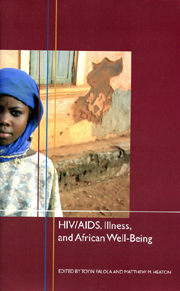Book contents
- Frontmatter
- Contents
- Acknowledgments
- Part I Context
- Part II Illness Case Studies
- Part III Globalization, Development, and Health
- Part IV HIV/AIDS
- 12 Of Savages and Mass Killing: HIV/AIDS, Africa and the Crisis of Global Health Governance
- 13 Vicissitudes of AIDS Policies in Burkina Faso from 1985 to 2001: A Historical Perspective
- 14 Factors Associated with Deliberate Attempts to Transmit HIV Infection among Persons Living with HIV/AIDS in Tanzania
- 15 Development and Alternative Mitigation Treatment Opportunities of the HIV/AIDS Epidemic
- 16 Confusion, Anger, and Denial: Results of HIV/AIDS Focus Group Discussions with Urban Adult Zimbabweans
- 17 Three Proposals for Analyzing the Economic Growth Effects of HIV/AIDS in Sub-Saharan Africa
- List of Contributors
- Index
- Rochester Studies in African History and the Diaspora
15 - Development and Alternative Mitigation Treatment Opportunities of the HIV/AIDS Epidemic
from Part IV - HIV/AIDS
Published online by Cambridge University Press: 05 February 2013
- Frontmatter
- Contents
- Acknowledgments
- Part I Context
- Part II Illness Case Studies
- Part III Globalization, Development, and Health
- Part IV HIV/AIDS
- 12 Of Savages and Mass Killing: HIV/AIDS, Africa and the Crisis of Global Health Governance
- 13 Vicissitudes of AIDS Policies in Burkina Faso from 1985 to 2001: A Historical Perspective
- 14 Factors Associated with Deliberate Attempts to Transmit HIV Infection among Persons Living with HIV/AIDS in Tanzania
- 15 Development and Alternative Mitigation Treatment Opportunities of the HIV/AIDS Epidemic
- 16 Confusion, Anger, and Denial: Results of HIV/AIDS Focus Group Discussions with Urban Adult Zimbabweans
- 17 Three Proposals for Analyzing the Economic Growth Effects of HIV/AIDS in Sub-Saharan Africa
- List of Contributors
- Index
- Rochester Studies in African History and the Diaspora
Summary
Despite years of struggle against the disease, UNAIDS' Report on the Global HIV/AIDS Epidemic concluded that “the scale of the AIDS crisis now outstrips even the worst-case scenarios of a decade ago. Dozens of countries are already in the grip of serious HIV/AIDS epidemics, and many more are on the brink.” If billions of dollars per year over a lengthy period of time were going into Africa as well as being spent by those on the continent for anything other than combating a sexually transmitted disease, all parties would view it as an opportunity to develop private business and advance these nations economically. The fact that it is for a sexually transmitted disease in no way diminishes that potential.
While the epidemic is global, it is currently most prevalent and its potential for spread greatest in developing countries. Sub-Saharan Africa accounts for nearly three-quarters of all those currently infected, hence, the discussion in this chapter will focus there. The next most severely affected region is the Caribbean, and there are indications that HIV/AIDS is spreading rapidly in South Asia and the formerly socialist nations of Eastern Europe and Central Asia. Reported infection rates in China are low, but many suspect they underestimate actual prevalence rates and that the risks of significant increases are high.
The picture is not entirely bleak. There have been more effective life-prolonging medicines developed, such as HAART; work continues to find a cure and immunization treatments; and cases such as Uganda and Thailand suggest that the progression of the disease can be stopped and, perhaps, reversed.
- Type
- Chapter
- Information
- HIV/AIDS, Illness, and African Well-Being , pp. 324 - 351Publisher: Boydell & BrewerPrint publication year: 2007

